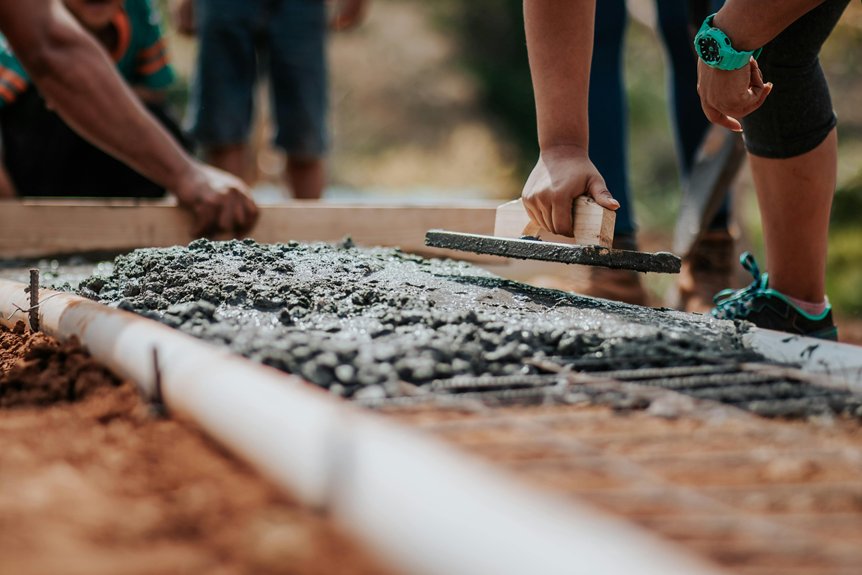Concrete cement mix entails selecting the appropriate type of cement, specifically Portland cement types I, II, III, or V, tailored to the requirements of the project. This mix comprises precise ratios of cement, sand, aggregate, and water to achieve the desired strength and durability, often denoted by grades such as M15, M20, or M25.
Additives, commonly referred to as admixtures, enhance workability and longevity. A thorough understanding of these components is crucial for ensuring a robust and enduring structure. Further insights into optimising concrete for various applications can provide invaluable guidance for successful outcomes in construction projects.
When considering the various elements that contribute to the effectiveness of concrete, attention to detail is key. This includes assessing the quality of materials and their compatibility, which ultimately influences the performance of the final product.
As a builder or contractor, keeping abreast of the latest techniques and materials will enable you to achieve the best results in your concrete applications.
Types of Cement Used in Concrete Mixes
Different types of cement are utilised in concrete mixes depending on the specific requirements of a construction project. Portland cement comes in several varieties, each suited for distinct conditions. Type I is versatile and is used where no special properties are needed, making it ideal for general construction. Type II provides moderate resistance to sulphates, making it suitable for underground or roadway projects. Type III develops high early strength, which is perfect for cold weather or projects that require quick turnarounds. Type IV generates less heat during setting, which is beneficial for large pours to prevent cracking. Type V is designed to withstand severe sulphate exposure, making it useful for coastal or underwater structures. Additionally, specialised cements such as rapid hardening or sulphate-resistant types enhance durability and expedite construction processes. Selecting the appropriate cement is crucial for ensuring the longevity and reliability of the project, especially considering the diverse performance characteristics required for different environmental conditions.
Understanding Concrete Mix Ratios and Grades
Understanding concrete mix ratios and grades is crucial for achieving the desired strength, durability, and workability in construction projects. Mix ratios, such as 1:2:4 or 1:1.5:3, indicate the volumes of cement, sand, and aggregate used, which directly affect the performance of the concrete. Different grades, like M15, M20, and M25, denote the concrete’s compressive strength after a specified curing period, guiding material choices and determining the suitability for various applications.
Higher grades, such as M30 and above, necessitate meticulously designed mixes tailored to specific structural requirements.
| Mix Ratio | Typical Strength (N/mm²) | Common Use |
|---|---|---|
| 1:2:4 | Approx. 15 | Pavements, flooring |
| 1:1.5:3 | Approx. 20 | Residential slabs, beams |
| 1:1:2 | Approx. 25 | Commercial structures |
| Above M30 | Custom-designed | Heavy-duty and high-strength |
In the UK, understanding these ratios and grades allows builders and engineers to select appropriate materials for their projects, ensuring that the finished structure meets the necessary safety and performance standards.
Components and Additives for Optimizing Concrete Performance
Components and additives play a crucial role in enhancing the performance of concrete by modifying its properties to meet specific construction requirements.
Water-reducing admixtures, such as plasticisers and superplasticisers, significantly improve workability and strength by reducing water content without compromising ease of placement.
Air-entraining agents introduce tiny air bubbles into the mix, which enhances durability in colder climates by providing resistance against freeze-thaw cycles.
Set time modifiers, including accelerators and retarders, facilitate control over the hardening process of concrete, making it adaptable to various project timelines and weather conditions.
Additives like silica fume and fly ash contribute to strengthening the microstructure, resulting in greater longevity and durability.
Additionally, corrosion inhibitors serve to protect embedded steel from potential damage.
Selecting the appropriate combination of components ensures that concrete not only performs optimally but also meets the specific environmental and structural demands of each project.
Conclusion
Selecting the appropriate type of cement and mix ratio is crucial for creating durable concrete. A clear understanding of the components and additives involved helps to enhance strength, workability, and longevity. Various mixes are tailored for specific construction needs, ranging from basic pathways to intricate structures.
By meticulously choosing materials and adhering to proper procedures, builders can ensure that concrete performs effectively under diverse conditions. A comprehensive knowledge of these elements leads to improved results and more enduring projects, establishing concrete as a reliable and versatile building material.
When considering your concrete mix, it’s essential to focus on quality and suitability for your particular application. This thoughtful approach will not only enhance the performance of the concrete but also contribute to the overall success of your construction endeavours.

